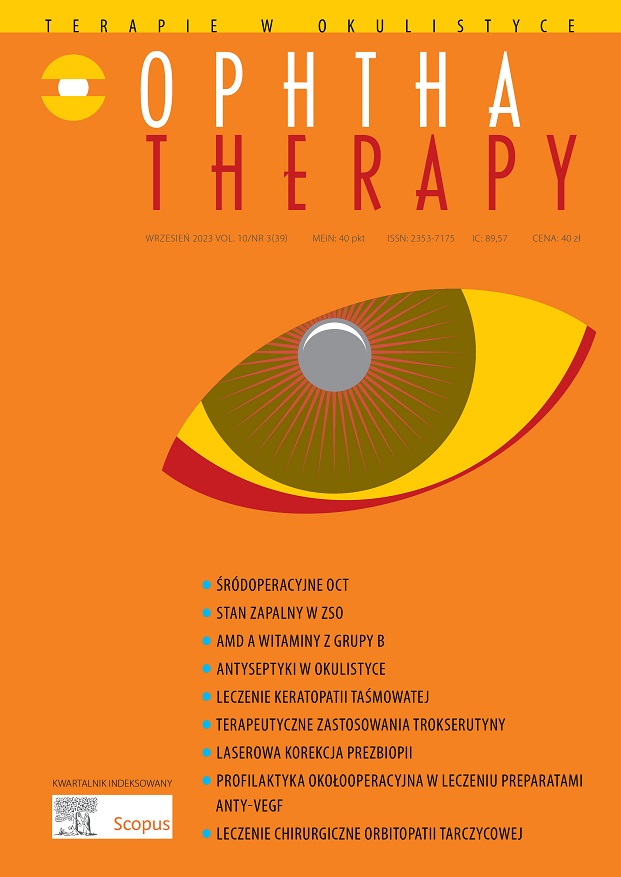Rola witamin z grupy B w rozwoju i progresji zwyrodnienia plamki związanego z wiekiem Artykuł przeglądowy
##plugins.themes.bootstrap3.article.main##
Abstrakt
W ostatnich latach analizowana jest rola witamin z grupy B jako biologicznie aktywnych składników odżywczych o możliwym działaniu zapobiegającym rozwojowi i postępowi zwyrodnienia plamki żółtej związanego z wiekiem. Praca jest przeglądem piśmiennictwa z ostatnich ok. 10 lat podejmującego tematykę właściwości witamin z grupy B oraz badań dostarczających danych epidemiologicznych o ich spożyciu i koncentracji w osoczu, a także ich wpływie na progresję zwyrodnienia u chorych.
Przegląd potwierdza istotną korzystną rolę witamin z grupy B w ograniczaniu rozwoju i postępu zwyrodnienia plamki. Mimo to potrzebne są kolejne randomizowane badania ukierunkowane na ocenę diety i oznaczenie wybranych przeciwutleniaczy w osoczu w dłuższym, co najmniej kilkuletnim okresie przy jednoczesnym uwzględnieniu szeregu modyfikowalnych i niemodyfikowalnych czynników ryzyka choroby.
Pobrania
##plugins.themes.bootstrap3.article.details##

Utwór dostępny jest na licencji Creative Commons Uznanie autorstwa – Użycie niekomercyjne – Bez utworów zależnych 4.0 Międzynarodowe.
Copyright: © Medical Education sp. z o.o. License allowing third parties to copy and redistribute the material in any medium or format and to remix, transform, and build upon the material, provided the original work is properly cited and states its license.
Address reprint requests to: Medical Education, Marcin Kuźma (marcin.kuzma@mededu.pl)
Bibliografia
2. Thomas CJ, Mirza RG, Gill MK. Age-Related Macular Degeneration. Med Clin North Am. 2021; 105(3): 473-91. http://doi.org/10.1016/j.mcna.2021.01.003.
3. Heesterbeek TJ, Lorés-Motta L, Hoyng CB et al. Risk factors for progression of age-related macular degeneration. Ophthalmic Physiol Opt. 2020; 40(2): 140-70. http://doi.org/10.1111/opo.12675.
4. García-Layana A, Cabrera-López F, García-Arumí J et al. Early and intermediate age-related macular degeneration: update and clinical review. Clin Interv Aging. 2017; 12: 1579-87. http://doi.org/10.2147/CIA.S142685.
5. Stahl A. The Diagnosis and Treatment of Age-Related Macular Degeneration. Dtsch Arztebl Int. 2020; 117(29-30): 513-20. http://doi.org/10.3238/arztebl.2020.0513.
6. Campa C, Parodi MB. Anti-VEGF Therapy for Ocular Diseases: Present and Future. Curr Drug Targets. 2020; 21(12): 1158. http://doi.org/10.2174/138945012112200727153907.
7. Agron E, Mares J, Clemons TE et al. Dietary Nutrient Intake and Progression to Late Age-Related Macular Degeneration in the Age-Related Eye Disease Studies 1 and 2. Ophthalmology. 2021; 128(3): 425-42.
8. Van Leeuwe EM, Emri E, Merle BMJ et al. A new perspective on lipid research in age-related macular degeneration. Prog Retin Eye Res. 2018; 67: 56-86. http://doi.org/10.1016/j.preteyeres.2018.04.006.
9. Merle BM, Silver RE, Rosner B et al. Adherence to a Mediterranean diet, genetic susceptibility, and progression to advanced macular degeneration: a prospective cohort study. Am J Clin Nutr. 2015; 102(5): 1196-206. http://doi.org/10.3945/ajcn.115.111047.
10. Chew EY. Nutrition effects on ocular diseases in the aging eye. Invest Ophthalmol Vis Sci. 2013; 54(14): ORSF42-7. http://doi.org/10.1167/iovs13-12914.
11. Pietrzik K, Bailey L, Shane B. Folic acid and L-5-methyltetrahydrofolate: comparison of clinical pharmacokinetics and pharmacodynamics. Clin Pharmacokinet. 2010; 49(8): 535-48. http://doi.org/10.2165/11532990-000000000-00000.
12. Pope S, Artuch R, Heales S et al. Cerebral folate deficiency: Analytical tests and differential diagnosis. J Inherit Metab Dis. 2019; 42(4): 655-72. http://doi.org/10.1002/jimd.12092.
13. Green R, Datta Mitra A. Megaloblastic Anemias: Nutritional and Other Causes. Med Clin North Am. 2017; 101(2): 297-317. http://doi.org/10.1016/j.mcna.2016.09.013.
14. Devalia V, Hamilton MS, Molloy AM; British Committee for Standards in Haematology. Guidelines for the diagnosis and treatment of cobalamin and folate disorders. Br J Haematol. 2014; 166(4): 496-513. http://doi.org/10.1111/bjh.12959.
15. Tahiliani AG, Beinlich CJ. Pantothenic acid in health and disease. Vitam Horm. 1991; 46: 165-228. http://doi.org/10.1016/s0083-6729(08)60684-6.
16. Gheita AA, Gheita TA, Kenawy SA. The potential role of B5: A stitch in time and switch in cytokine. Phytother Res. 2020; 34(2): 306-14. http://doi.org/10.1002/ptr.6537.
17. Alemán G, Tovar AR, Torres N. Homocysteine metabolism and risk of cardiovascular diseases: importance of the nutritional status on folic acid, vitamins B6 and B12. Rev Invest Clin. 2001; 53(2): 141-51.
18. Ryan-Harshman M, Aldoori W. Vitamin B12 and health. Can Fam Physician. 2008; 54(4): 536-41.
19. Fenech M. Folate (vitamin B9) and vitamin B12 and their function in the maintenance of nuclear and mitochondrial genome integrity. Mutat Res. 2012; 733(1-2): 21-33. http://doi.org/10.1016/j.mrfmmm.2011.11.003.
20. Gopinath B, Flood VM, Rochtchina E et al. Epidemiologic evidence of a relation between serum total homocysteine (tHcy), vitamin B-12, and folate and age-related macular degeneration (AMD) is inconsistent and unresolved. Am J Clin Nutr. 2013; 98(1): 129-35. http://doi.org/10.3945/ajcn.112.057091.
21. Huang P, Wang F, Sah BK et al. Homocysteine and the risk of age-related macular degeneration: A systematic review and meta-analysis. Sci Rep. 2015; 5: 10585. http://doi.org/10.1038/srep10585.
22. Pinna A, Zaccheddu F, Boscia F et al. Homocysteine and risk of age-related macular degeneration: A systematic review and meta-analysis. Acta Ophthalmol. 2018; 96(3): e269-e276. http://doi.org/10.1111/aos.13343.
23. Christen WG, Cook NR, Chiuve SE et al. Prospective study of plasma homocysteine, its dietary determinants, and risk of age-related macular degeneration in men. Ophthalmic Epidemiol. 2018; 25(1): 79-88.
24. Merle BM, Silver RE, Rosner B et al. Dietary folate, B vitamins, genetic susceptibility and progression to advanced nonexudative age-related macular degeneration with geographic atrophy: A prospective cohort study. Am J Clin Nutr. 2016; 103(4): 1135-44.
25. Gopinath B, Liew G, Russell J et al. Intake of key micronutrients and food groups in patients with late-stage age-related macular degeneration compared with age-sex-matched controls. Br J Ophthalmol. 2017; 101(8): 1027-31. http://doi.org/10.1136/bjophthalmol-2016-309490.
26. Christen WG, Glynn RJ, Chew EY et al. Folic acid, pyridoxine, and cyanocobalamin combination treatment and age-related macular degeneration in women: The Women’s Antioxidant and Folic Acid Cardiovascular Study. Arch Intern Med. 2009; 169(4): 335-41.
27. Merle BMJ, Barthes S, Féart C et al. B Vitamins and Incidence of Advanced Age-Related Macular Degeneration: The Alienor Study. Nutrients. 2022; 14(14): 2821. http://doi.org/10.3390/nu14142821.
28. Merle BMJ, Cougnard-Grégoire A, Korobelnik JF et al. Plasma Lutein, a Nutritional Biomarker for Development of Advanced Age-Related Macular Degeneration: The Alienor Study. Nutrients. 2021; 13(6): 2047.
29. Pameijer EM, Heus P, Damen JAA et al. What did we learn in 35 years of research on nutrition and supplements for age-related macular degeneration: a systematic review. Acta Ophthalmol. 2022; 100(8): e1541-e1552. http://doi.org/10.1111/aos.15191.

